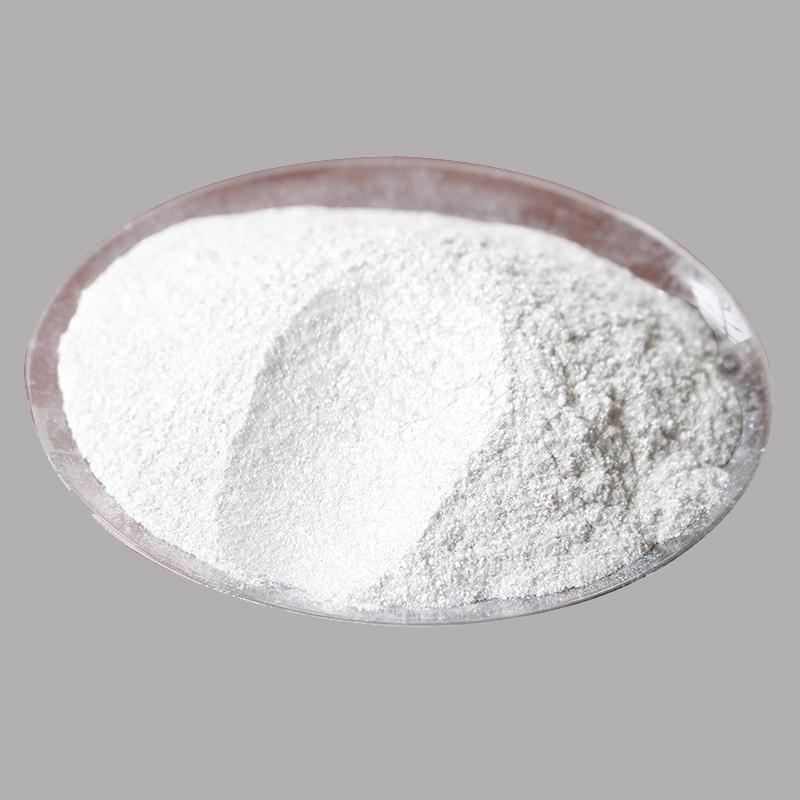Chemical formula: C6H12N2S4Molecular weight: 240.433CAS no. : 137-26-8 Chemical properties:Pure product is colorless crystal, no smell. M.p. 155 ~ 156℃, relative density 1.29. Easily soluble in benzene, chloroform (230g/L), acetone (80g/L, Chemicalbook carbon disulphide and other organic solvents, slightly soluble in ether and ethanol (& LT; 10g/L), insoluble in water (30mg/L). It breaks down in acid. Industrial product is white or light yellow powder, M.P.
Связаться сейчас
Physical and chemical properties:The pure product is colorless crystal and has no smell. m.p.155~156℃, relative density 1.29. easily soluble in benzene, chloroform (230g/l), acetone (80g/l, carbon disulfide and other chemicalbook organic solvents, barely soluble in ether and ethanol (<10g/l), insoluble in water (30mg/l). decomposes in acid.
Связаться сейчас
Molecular formula: C4H6N2S4ZnMolecular weight: 276.7802CAS:12122-67-7 Physical property :1. Properties: off-white powder, industrial products are light yellow powder, slightly rotten egg taste, strong moisture absorption.2. Melting point (℃) : decomposition3. Relative density (water =1) : 1.74 (20℃)4. Octanol/water partition coefficient: 1.35. Solubility: insoluble in water, dissolved in carbon disulfide, pyridine, insoluble in most organic solvents. Toxicity:1. Acute toxicityLD50: > 5200mg/kg (rat oral)LC50:1850mg/m3 (rat inhalation)2. No data on irritation3.
Связаться сейчас
Common name: ThiramChemical name:tetramethylthioperoxydicarbonic diamide ([[(CH3)2N]C(S)]2S2); tm-95; Thiuram (Thiram)Molecular formula: C6H12N2S4Structural formula:Molecular weight: 240.43CAS No. : 137-26-8Physical and chemical properties:The pure product is colorless crystal and has no odor. m.p.155~156℃, relative density 1.29. Easily soluble in benzene, chloroform (230g/L), acetone (80g/L, carbon disulfide and other Chemicalbook organic solvents, slightly soluble in ether and ethanol (<10g/L), insoluble in water (30mg/L). Decomposes in acid.
Связаться сейчас
Physical and chemical properties:Chemical formula C14H20ClNO2Density: 1.1 g/cm3Boiling point: 391.5 ℃Refractive index: 1.5272 (20℃)Appearance: Light brown liquid Toxicology :1. Skin and eye irritation and toxicityRabbit skin Draize standard test: 500mg/24h2. Acute toxicityRat transoral LD50:763mg/kgRat peritoneal LD50:1200mg/kgMice transoral LD50:1550mg/kgRabbit transoral LD50:600mg/kgRabbit skin LDLo: 1260mg/kg3.
Связаться сейчас
Structural formula:· Molecular weight: 255.66· CAS No. : 105827-78-9Physical and chemical properties:Pure product is white crystal, M.P. 143.8℃ (A), 136.4℃ (B), vapor pressure 2×10-7Pa (20℃)Specifications:97%TC, 25%WP, 10%WP, 70%WP, 35%SC, 60%FCProduct description:Imidacloprid is a systemic insecticide belonging to a class of chemicals called the neonicotinoids which act on the central nervous system of insects. The chemical works by interfering with the transmission of stimuli in the insect nervous system.
Связаться сейчас
Bifenthrin is a pyrethroid insecticide. it's miles extensively used in opposition to ant infestations, consisting of the invasive crimson fireplace ant, through influencing its apprehensive machine. it has a high toxicity to aquatic organisms.Bifenthrin is poorly soluble in water and often remains in soil. Its residual half-life in soil is between 7 days and 8 months, depending on the soil type, with a low mobility in most soil types. Bifenthrin has the longest known residual time in soil of insecticides currently on the market. It is a white, waxy solid with a faint sweet smell.
Связаться сейчас
Alachlor is an herbicide from the chloroacetanilide family. It is an odorless, white solid. The greatest use of alachlor is for control of annual grasses and broadleaf weeds in crops. Use of alachlor is illegal in the European Union and no products containing alachlor are currently registered in the United States.Its mode of action is elongase inhibition, and inhibition of geranylgeranyl pyrophosphate (GGPP) cyclisation enzymes, part of the gibberellin pathway. Common name: AlachlorChemical name: 2-chloro-N-(2,6-diethylphenyl)-N-(methoxymethyl)acetamide; Molecula
Связаться сейчас
Common name: FluroxypyrChemical name: 4-amino-3,5-dichloro-6-fluoro-2-pyridyloxyacetic acidMolecular formula: C7H5Cl2FN2O3Structural formula:Molecular weight: 255.03CAS No. : 69377-81-7 Product description:Fluroxypyr is an organic heterocyclic selective systemic and conductive post-emergence herbicide. Its general name is fluroxypyr, and other names include Zhipinling. It is suitable for the control of wheat, barley, corn and other gramineous crops. Various broad-leaved weeds.
Связаться сейчас
Usage:Pyrethroid is a tactile, gastrotoxic pyrethroid insecticide. used to control pests on cotton, veggies, tobacco and other crops.Chemical name: (1R,3R)-3-((Z)-2-Chloro-3,3,3-trifluoro-propenyl)-2,2-dimethyl-cyclopropanecarboxylic acid (S)-cyano-(3-phenoxy-phenyl)-methyl esterMolecular formula: C23H19ClF3NO3Structural formula:Molecular weight: 449.85CAS No. : 91465-08-6Physical and chemical properties:Pure product is white solid, industrial product is light yellow solid.
Связаться сейчас
Common name: propazineChemical name: 2-Chloro-4,6-diisopropylamino-1,3,5-triazine.Molecular formula: C9H16ClN5Structural formula:Molecular weight: 229.71CAS No. : 139-40-2Product description:Triazines are systemic and selective herbicides. The pure product is colorless crystal with a melting point of 212~214℃ and a vapor pressure of 386.6×10-8Pa at 20℃. It is almost insoluble in water and hardly soluble in organic solvents, but it can be recrystallized from 2-ethoxyethanol and dimethylformamide.
Связаться сейчас
Product description:Internal carbamate insecticide, both pesticide and stomach toxicity, can successfully manipulate a ramification of pests and their larvae and eggs, the residual impact is brief. manipulate cotton bollworm, cotton miner moth, tobacco moth with 24% water spray 24-36ml /100m2. foliar spray also can be used to manipulate aphids, thrips, red spider, leaf roll worms, slime worms, and so on., and soil remedy to control nematodes and leaf pests. in 1966, it changed into first endorsed by way of du pont as insecticide and nematocide.
Связаться сейчас
CAS: 110488-70-5MF: C21H22ClNO4MW: 387.86 Physical chemistry properties:The melting point of 125-149 ° CVapor pressure 1 x 10-6 Pa (25 °C)Sealed in dry,Room TemperatureWater solubility 50 mg L -1 (20-23 °C) Toxicity:The acute oral LD50 of rats was greater than 3900 mg/kg, the transcutaneous LD50 was greater than 2000 mg/kg, and the acute inhaled LC50 of rats was greater than 4.24 mg/L.It has no irritation to rabbit skin, slight irritation to eyes, and no sensitization to guinea pigs.No mutagenic, teratogenic and carcinogenic effects were observed under the test conditions.
Связаться сейчас
Common name: SimazineChemical name:6-chloro-N,N’-diethyl-1,3,5-triazine-2,4-diamine; 6-chloro-N2,N4-diethyl-1,3,5-triazine-2,4-diamine; 2,4-Bis(ethylamino)-6-chloro-1,3,5-triazineMolecular formula: C7H12ClN5Structural formula:Molecular weight: 201.66CAS No. : 122-34-9 Physical and chemical properties:The pure product is white crystals. m.p.226~227℃, vapor pressure 8.13×10-7Pa(20℃). The solubility in methanol is 400mg/L, the solubility in water is 5mg/L, the solubility of in petroleum ether is 2mg/L, and it is slightly soluble in chloroform.
Связаться сейчас
Structural formula:Molecular weight: 511.15CAS No.
Связаться сейчас
Common name: Thiophanate-MethylChemical name: Dimethyl N,N′-[1,2-phenylenebis(azanediylcarbonothioyl)]dicarbamateMolecular formula: C12H14N4O4S2Structural formula:Molecular weight: 342.39CAS No. : 23564-05-8 Physical and chemical properties:The pure product is colorless crystal, m.p. 177~178℃ (decomposition), easily soluble in dimethylformamide and chloroform; soluble in acetone, methanol, ethanol, ethyl acetate, dioxane; insoluble in water. Stable to acid and alkali.
Связаться сейчас
Common name: MesotrioneChemical name:2-[4-(methylsulfonyl)-2-nitrobenzoyl]-1,3-cyclohexanedioneMolecular formula: C14H13NO7SStructural formula:Molecular weight: 339.32CAS No. : 104206-82-8Product description:Mesotrione is an effective inhibitor of HPPD (4-hydroxyphenylpyruvate dioxidase), which is widely present in various organisms and catalyzes the initial reaction of plastoquinone and tocopherol biosynthesis.
Связаться сейчас
Common name: 2,4-DChemical name:2,4-dichlorophenoxy-acetic acid; (2,4-dichlorophenoxy)acetic acid; Acetic acid, 2-(2,4-dichlorophenoxy)-Molecular formula: C8H6Cl2O3Structural formula: Molecular weight: 221.04CAS No. : 94-75-7Physical and chemical properties:White crystals. Melting point is 138°C, boiling point is 160°C (53Pa). Soluble in organic solvents such as ethanol, acetone, ether and benzene, but insoluble in water. Rat oral LD50375mg/kg.Usage:Used as plant growth regulator, antiseptic and fresh-keeping agent. It can be used in compatibility with other disinfectants.
Связаться сейчас
Common name: TebuconazoleChemical name:1-(4-Chlorophenyl)-4,4-dimethyl-3-(1,2,4-triazole-1-yl-methyl)pentane-3-olMolecular formula: C16H22ClN3OStructural formula: Molecular weight: 307.82CAS No. : 80443-41-0Product description:Tebuconazole is a kind of high efficiency, broad spectrum, internal absorption triazole bactericidal pesticide, with three functions of protection, treatment, eradication, wide bactericidal spectrum, long duration of efficacy. It was found that tebuconazole, like all triazole fungicides, could inhibit the biosynthesis of ergosterol from fungicide.
Связаться сейчас
AzaconazoleChemical name:1-[[2-(2,4-dichlorophenyl)-1,3-dioxolan-2-yl]methyl]-1,2,4-triazole Molecular formula: C12H11Cl2N3O2Structural formula:Molecular weight: 300.1406CAS No. : 60207-31-0Physical and chemical properties:Density: 1.51 g/cm3Melting point: DHS 112.6 CBoiling point: 460.7ºC at 760 mmHgFlash: DHS 232.4 CRefractive index: 1.658Storage conditions: 0-6ºC
Связаться сейчас
Product description:Propiconazole is a triazole fungicide, also referred to as a dmi, or demethylation inhibiting fungicide due to its binding with and inhibiting the 14-alpha demethylase enzyme from demethylating a precursor to ergosterol. with out this demethylation step, the ergosterols are not protected into the growing fungal cellular membranes, and cellular increase is stopped.Common name: PropiconazoleChemical name:1-[[2-(2,4-dichlorophenyl)-4-propyl-1,3-dioxolan-2-yl]methyl]-1H-1,2,4-triazoleMolecular formula: C15H17Cl2N3O2 Structural formula:Molecular weight: 342.22CAS No.
Связаться сейчас
Common name: EpoxiconazoleChemical name:1-[[3-(2-chlorophenyl)-2-(4-fluorophenyl)oxiran-2-yl]methyl]-1,2,4-triazole Molecular formula: C17H13ClFN3OStructural formula: Molecular weight: 329.76CAS No. : 135319-73-2Product description: Epoxiconazole is a fungicide active ingredient from the class of azoles developed to protect crops. In particular, the substance inhibits the metabolism of fungi cells infesting useful plants, and thereby prevents the growth of the mycelia (fungal cells). Epoxiconazole also limits the production of conidia (mitospores).
Связаться сейчас
Product description:Difenoconazole, also referred to as oxadifenazole, is a triazole fungicide and a sterol demethylation inhibitor. it has the characteristics of high performance, wide spectrum, low toxicity, and low dosage. an incredible kind of triazole fungicides with strong systemic houses. by using inhibiting the biosynthesis of ergosterol in pathogenic cells, it destroys the structure and characteristic of pathogen cell membranes. it is used in fruit trees, chemicalbook greens, wheat, potatoes, beans, melons, and so on.
Связаться сейчас
Common name: PropiconazoleChemical name:1-[[2-(2,4-dichlorophenyl)-4-propyl-1,3-dioxolan-2-yl]methyl]-1H-1,2,4-triazoleMolecular formula: C15H17Cl2N3O2 Structural formula:Molecular weight: 342.22CAS No. : 60207-90-1Product description:Propiconazole is a triazole fungicide, also known as a DMI, or demethylation inhibiting fungicide due to its binding with and inhibiting the 14-alpha demethylase enzyme from demethylating a precursor to ergosterol.
Связаться сейчас


































